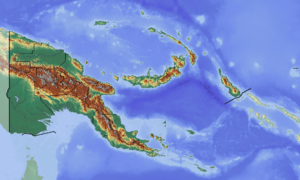Sumgilbar Rural LLG
Sumgilbar Rural LLG is a local-level government (LLG) of Madang Province, Papua New Guinea.[1][2]
Sumgilbar Rural LLG | |
|---|---|
 Sumgilbar Rural LLG Location within Papua New Guinea | |
| Coordinates: 4.818469°S 145.771952°E | |
| Country | Papua New Guinea |
| Province | Madang Province |
| Time zone | UTC+10 (AEST) |
Wards
- 01. Bunbun (Brem language speakers)
- 02. Erenduk
- 03. Murukanam (Brem language speakers)
- 04. Malas (Manep and Waskia language speakers)
- 05. Imbab (Yamben language speakers)[3][4]
- 06. Mirap (Gavak language speakers)
- 07. Karkum (Gavak language speakers)
- 08. Sarang
- 09. Basken (Gavak language speakers)
- 10. Budum
- 11. Garup (Bargam language speakers)
- 12. Megiar (Bargam language speakers)
- 13. Biranis (Bargam language speakers)
- 14. Liksal (Bargam language speakers)
- 15. Barag / Aronis (Bargam language speakers)
- 16. Bunu No.1 (Bargam language speakers)
- 17. Kudas (Bargam language speakers)
- 18. Wasab (Bargam language speakers)
- 19. Burbura
- 20. Bagildik
- 21. Deda
- 22. Bomasse
- 23. Bandimfok
- 24. Asiwo
- 25. Abab
- 26. Dimert
- 27. Bilakura
- 28. Embor
- 29. Perene
- 30. Katekot
- 31. Hinihon
gollark: But this is an esolang, so I doubt it's very efficiently implemented, and this might be doing some sort of inefficient stuff itself.
gollark: I mean, 2^32 is actually within tractable computation range for modern computers (it's 2 billion or so, and my laptop can probably manage 8GIPS (giga-instructions per second) sequentially).
gollark: This is the problem - with ones which are too long they can't be really tested.
gollark: In decently general-purpose programming languages with access to more space, you can construct ridiculously large numbers by implementing ↑ and all that.
gollark: Not without extra imports or something. or maybe python2.
References
- "Census Figures by Wards - Momase Region". www.nso.gov.pg. 2011 National Population and Housing Census: Ward Population Profile. Port Moresby: National Statistical Office, Papua New Guinea. 2014.
- "Final Figures". www.nso.gov.pg. 2011 National Population and Housing Census: Ward Population Profile. Port Moresby: National Statistical Office, Papua New Guinea. 2014.
- Pick, Andrew (2019). "Gildipasi language project: tumbuna stories and tumbuna knowledge". Endangered Languages Archive at SOAS, University of London.
- United Nations in Papua New Guinea (2018). "Papua New Guinea Village Coordinates Lookup". Humanitarian Data Exchange. 1.31.9.
- OCHA FISS (2018). "Papua New Guinea administrative level 0, 1, 2, and 3 population statistics and gazetteer". Humanitarian Data Exchange. 1.31.9.
- United Nations in Papua New Guinea (2018). "Papua New Guinea Village Coordinates Lookup". Humanitarian Data Exchange. 1.31.9.
This article is issued from Wikipedia. The text is licensed under Creative Commons - Attribution - Sharealike. Additional terms may apply for the media files.